|
Sarajevo


 |
What to see
Sarajevo Old Town
Containing the legacy of Ottoman rule this old town centre is known as
Bascarsija. It is built on a model of of 'suk' of Arabic town centre
with numerous narrow allys. Gazi Hucerb Begs and another mosque are two
prominent buildings apart from sections of many different shops. Some
good restaurents serving Bosnian specialty are also located here. If on
budget enjoy a Turkish coffee and Burek watching the 'life and bazar'.
Tunel Museum
Many
of the other VT pages for Sarajevo include the airport tunnel and this
site is well worth visiting. The siege of Sarajevo lasted 3 years and
the only way out was for people to scamper across the airport runway,
exposed to Serb gunfire. Many were killed and wounded in the attempt.
Early on in the siege, people brought up the idea of a tunnel but it was
only after a couple of years that one was built. The airport was
controlled by UN forces but they were supposed to stay strictly neutral
and any humanitarian delieveries were to be split evenly between the
besiegers and the besieged. Food, weapons, ammunition, medical supplies,
all were scarce in the city. The tunnel helped ameliorate the situation
somewhat. The Serbs knew that the Muslims were building a tunnel and
complained bitterly to the UN forces, but they never knew exactly where
the tunnel was since the entrances were cleverly hidden. Today, the
cityside tunnel entrance is the Tunnel Cafe, a small cafe just past the
airport. On the mountain side of the airport, the entrance came out next
to a house, whose family today has made a small museum and has kept a
small section of the tunnel intact for visitors to peruse. The tunnel
had to be deep enough to stand up to the vibrations of plane traffic
above which meant it had to go deep. This meant that the tunnel was
occasionally flooded when the water table was high, thus, closing the
tunnel for periods of time. To visit you drive through a rural suburb
that is in various stages of repair - some very nice houses and some
very shot-up homes. It is a well-worthwhile trip that should be combined
with a visit to the City Historical Museum for a better understanding of
the events that went on here.
National Museum
Since the very beginning of its
work, the National Museum has developed as a complex cultural and
scientific institution nourishing a number of scientific and scholarly
disciplines, i.e. history, geography, archeology (prehistoric, ancient
and medieval), ethnology, history of art and natural history (biology,
geology and mineralogy), partly language, literature, statistics and
bibliography. Studies of these disciplines have with time taken the
shape of the three present departments, namely the Department of
Archeology, Department of Ethnology and Department of Natural History.
The Call of Imam
Very few cities in Europe have a
Muslim majority. There are over 80 mosques in Sarajevo - some date from
the 1500's and some are much newer. In the western parts of the city,
there are huge modernistic mosques serving the people living in the many
apartment towers. One especially grand newer mosque near the Bosnia TV
building on Marsahl Tito Boulevarde was a gift from Saudi Arabia. There
are five calls to prayer with the first coming when the imam can first
tell the difference between night and day - about 4 am in early July,
here in Sarajevo. Many mosques use loudspeakers, but at this mosque,
next to the Bascarsija square, you can still see the imam coming out on
top of the minaret calling down to the faithful.
Umjetnicka Akademija, Sarajevo
One of the most stunningly
beautiful buildings in Sarajevo is the Umjetnicka Akademija (Academy of
Fine Arts), which sits on the banks of the Miljacka River. The Academy
building was originally an Evangelical church and was completed in 1899.
The Umjetnicka Akademija was also damaged in the war, although today you
can visit the gallery room and the cafe. |
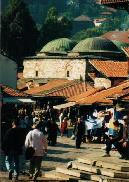
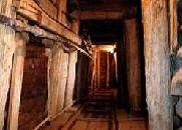
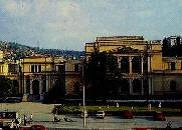
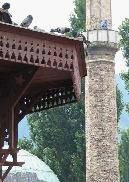
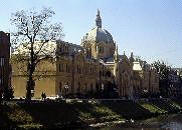 |